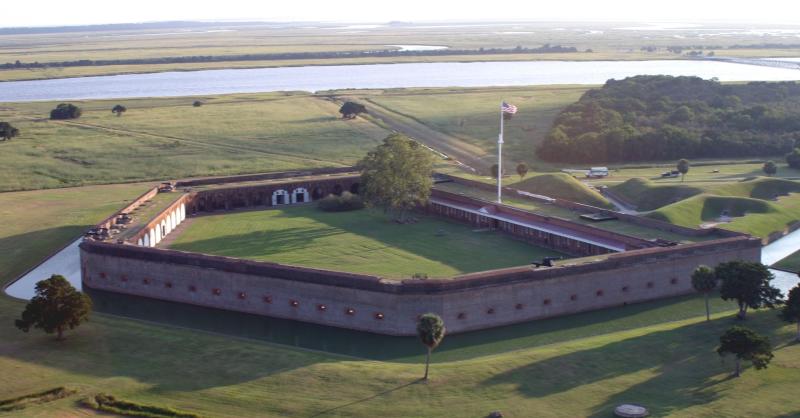A demilune (triangular detached earthwork) juts out from the west side of the fort, towards Savannah. It was intended to protect the flat "gorge" wall of the fort from direct battering fire. After the Civil War it was used for powder magazines, which are covered with bombproof style earthworks.
One of the bastions at the corners of the brick fort. Bastions are strong points that form the corners of a walled fortification. They jut out enough to provide enflilade fire on attackers approaching the main wall.
Unlike stockades like Fort Meigs, Fort Polaski was built as a permanent fortification, and incorporates a lot of elements you might see in a medieval castle. This is the windlass and chain supporting a drawbridge over the moat. The main gatehouse of the fort has a drawbridge as well as a portcullis.
A better view of one of the bastions.
The main gate is set into the gorge wall, protected from assault by the bastions and from battering fire by the demilune.
The two rear bastions both help cover magazines. Unfortunately for the garrison, the magazines could not be buried underground because of the high water table here.
"Cannon" is actually a grade of powder, extremely course. The grain system of powder courseness (from biggest to smallest grain: Cannon, Fg, FFg, FFFg, FFFFg) was developed later in the 19th century. Powder barrels would have been used to store and ship gunpowder, but it would have been measured and poured into silk or felt bags for use.
A 24-pounder howitzer is positioned on a pivot mount to sweep the drawbridge.
The garrison used a number of devices to help move and place their massive cannons. This two wheeled vehicle is a sling carriage, which could pick up and carry a heavy gun tube. The British left one of these machines behind after the siege of Fort Meigs, and it was subsequently used by the American garrison there.
Another machine for placing heavy guns is the gin. Basically a giant tripod and winch assembly that could hoist a gun tube off a travelling carriage or sledge and onto a garrison mount. The gunners at Fort Meigs are also known to have had one of these.
A closer view of the windlass or winch. Like a capstan, it was rotated by inserting a stout wooden bar into the drum.
The block and tackle part of the gin. 'Gin was originally short for "engine," meaning a simple machine.
One of the larger guns in the casemates. Handspikes can be used to lever against the truck (wheel) to manhandle the carriage forward on its slide, while the larger wheel seems to connect to the elevating screw underneath the breech.
A deconstructed view of part of the casemates, showing the masonry that extends beneath the floor planks. Fort Sumter in Charleston Harbor was a similar structure. By war's end it had been battered down into a nondescript mound, but like Monte Cassino during WWII, ruin only made it stronger.
A cannon on top of the wall, with a damaged muzzle.
A Brooke Rifle, a type of heavy rifled gun that was reinforced at the breech with iron bands. The increased pressure of rifled artillery loads forced designers to come up with ways to make their tubes stronger. Ultimately, the Bessimer steel making process made it feasible to construct guns out of steel-- a stronger material.
One of the larger guns in the casemates. Handspikes can be used to lever against the truck (wheel) to manhandle the carriage forward on its slide, while the larger wheel seems to connect to the elevating screw underneath the breech.
A deconstructed view of part of the casemates, showing the masonry that extends beneath the floor planks. Fort Sumter in Charleston Harbor was a similar structure. By war's end it had been battered down into a nondescript mound, but like Monte Cassino during WWII, ruin only made it stronger.
A cannon on top of the wall, with a damaged muzzle.
A Brooke Rifle, a type of heavy rifled gun that was reinforced at the breech with iron bands. The increased pressure of rifled artillery loads forced designers to come up with ways to make their tubes stronger. Ultimately, the Bessimer steel making process made it feasible to construct guns out of steel-- a stronger material.

















No comments:
Post a Comment
Note: Only a member of this blog may post a comment.